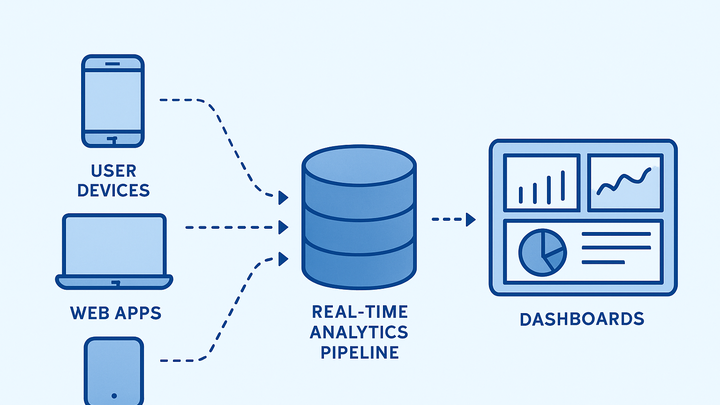Published on 2025-06-28T08:38:23Z
What is Streaming Data? Examples for Analytics
Streaming data refers to the continuous, real-time flow of event-driven data from sources such as web applications, IoT devices, and logs. In analytics, this data is ingested and processed instantly to provide up-to-the-moment insights, as opposed to batch processing which handles data at scheduled intervals. Key characteristics include high velocity, low latency requirements, and the ability to handle large volumes of small messages or events. Modern analytics platforms like PlainSignal and Google Analytics 4 (GA4) support streaming data ingestion to enable real-time dashboards, alerting, personalization, and anomaly detection. By integrating lightweight JavaScript snippets, events are transmitted directly to SaaS back-ends where they are processed, stored, and visualized on the fly. Streaming data pipelines often involve message brokers, real-time processing engines, and alerting systems to ensure data quality and timely action. Implementing streaming analytics requires attention to data governance, privacy regulations, and system scalability. The result is a powerful feedback loop that drives faster decision-making and improves user experiences.
Streaming data
Continuous, real-time data ingestion and processing for instant analytics insights and actions.
Core Concepts of Streaming Data
Streaming data is the ongoing, real-time sequence of small, discrete events that are processed immediately upon arrival. Unlike batch systems, which collect and process data in chunks at intervals, streaming analytics handles each event as it happens. Key properties include:
-
Velocity and volume
Data enters the system at high speed and often in large quantities, requiring scalable ingestion and processing infrastructure.
-
Event-driven architecture
Each piece of data is modeled as an event (e.g., a page view, click, sensor reading) that triggers real-time processing pipelines.
-
Latency and throughput
Low latency ensures insights are available immediately, while high throughput defines the system’s capacity to handle many events per second.
Why Streaming Data Matters in Analytics
Real-time analytics transforms raw events into actionable insights instantly. Organizations leverage streaming data to:
-
Real-time monitoring
Detect website errors, performance issues, or server anomalies as they occur to respond immediately.
-
Personalization and recommendations
Adjust content, offers, or user flows on the fly based on current user behavior.
-
Anomaly detection
Identify unusual spikes or drops in metrics (e.g., traffic surges, error rates) to trigger alerts or automated workflows.
Implementing Streaming Data with SaaS Analytics
Many SaaS analytics platforms provide plug-and-play support for streaming data. Below are two examples of how to integrate real-time event collection.
-
PlainSignal integration
PlainSignal offers a lightweight, cookie-free script for streaming pageview events in real-time. Add this to your <head>:
-
Code snippet
<link rel="preconnect" href="//eu.plainsignal.com/" crossorigin /> <script defer data-do="yourwebsitedomain.com" data-id="0GQV1xmtzQQ" data-api="//eu.plainsignal.com" src="//cdn.plainsignal.com/plainsignal-min.js"></script> -
Advantages
Privacy-friendly (no cookies), GDPR-compliant by default, minimal setup.
-
Limitations
Less granular user tracking and fewer advanced features compared to larger platforms.
-
-
Google analytics 4 (GA4)
GA4 natively streams event data to Google’s servers. To enable, insert the gtag.js snippet:
-
Code snippet
<script async src="https://www.googletagmanager.com/gtag/js?id=G-XXXXXXXXXX"></script> <script> window.dataLayer = window.dataLayer || []; function gtag(){dataLayer.push(arguments);} gtag('js', new Date()); gtag('config', 'G-XXXXXXXXXX'); </script> -
Advantages
Deep integration with Google ecosystem, advanced ML insights, robust user-centric reporting.
-
Limitations
Relies on cookies (requires consent), steeper learning curve for custom event modeling.
-
Best Practices and Considerations
Effective streaming analytics implementation hinges on data quality, privacy, and scalability. Key considerations include:
-
Data governance
Establish policies for retention, access controls, and lineage to ensure reliability and compliance.
-
Sampling and accuracy
Beware of sampling thresholds that can skew metrics in high-volume streams.
-
Privacy and compliance
Implement consent management, anonymization, and encryption to meet GDPR, CCPA, and other regulations.
-
Gdpr
Ensure explicit user consent and data minimization principles are followed.
-
Ccpa
Offer opt-out mechanisms and transparent data usage disclosures.
-
-
Scalability and performance
Choose platforms and architectures that can scale horizontally and maintain low latency as event volume grows.
